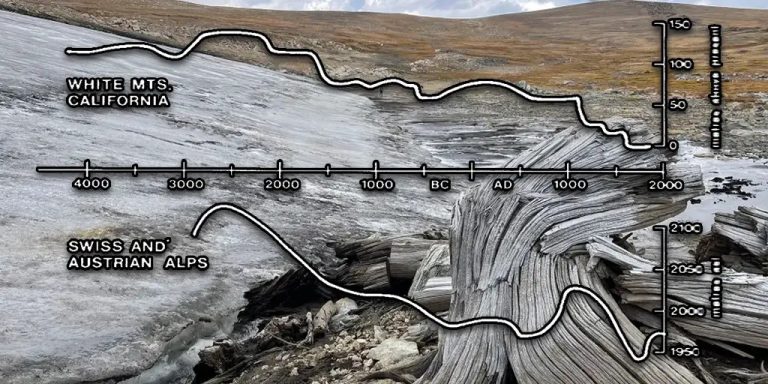not many people know
Paul Homewood
A patch of melting ice in the Rocky Mountains is revealing trees that grew 7,000 years ago:

significance
Recent warming has reduced snow and ice cover and increased the elevation of most subalpine treelines around the world. Mid-Holocene (approximately 5,950 to 5,440 years ago) whitebark pine forests preserved within perennial ice sheets in the Greater Yellowstone Ecosystem provide insights into the consequences of past climate change and ecosystem dynamics. When warm-season temperatures were similar to conditions in the mid-to-late 20th century, mid-Holocene treelines were approximately 180 meters above modern elevations. Subsequently, treeline elevations decreased due to cooling periods associated with increased volcanic activity, but primarily due to reduced summer insolation during the late Holocene. As current ice temperatures exceed the warmest conditions of the mid-Holocene, we expect regional ice losses and possible resumption of upslope treeline expansion.
abstract
Climate-driven changes in high-altitude forest distribution and reductions in ice and snow cover have significant consequences for ecosystems and global water security. In the Greater Yellowstone Ecosystem of the Rocky Mountains (USA), recent melting of high-altitude (3,091 m asl) ice has exposed mature whitebark pine (Pinus albicaulis) forests at an elevation of approximately 180 m above modern treeline, dating back By the middle of the Holocene (approximately 5,950 to 5,440 years ago). Here we use this subfossil wood record to provide tree-ring-based temperature estimates of the high-altitude climatic conditions that led to ancient forest establishment and growth and subsequent regional ice growth and downslope movement of treeline. The results show that mid-Holocene forest establishment and growth occurred at warm-season (May to October) temperatures averaging 6.2 °C (±0.2 °C) until multi-century cooling anomalies suppressed temperatures to 5.8 °C. C below, resulting in stand mortality c. 5,440 years ago. Transient climate model simulations suggest regional cooling is driven by changes in summer insolation and Northern Hemisphere volcanic activity. The initial cooling event was followed centuries later (approximately 5,100 years ago) by ongoing Icelandic volcanic eruptions, forcing a century-scale 1.0 °C cooling anomaly in the summer and leading to rapid ice growth and tree preservation. With recent warming (ca. 2000 AD to 2020 AD), warm season temperatures are now the same as high treeline mid-Holocene temperatures and will soon exceed them. Perennial ice sheets are likely to disappear from the area again, and tree lines may slope upward as long as moisture and disturbance available to plants are not limited.
https://www.pnas.org/doi/10.1073/pnas.2412162121
The paper falsely claims that recent warming is a new phenomenon, but provides no data to support this.
However, many tree line studies have conclusively shown that as early as the Middle Ages, tree lines in the Rocky Mountains were much higher than they are today.

HH Lamb: Climate, history and the modern world
Relevant
Learn more from Watts Up With That?
Subscribe to have the latest posts delivered to your email.
